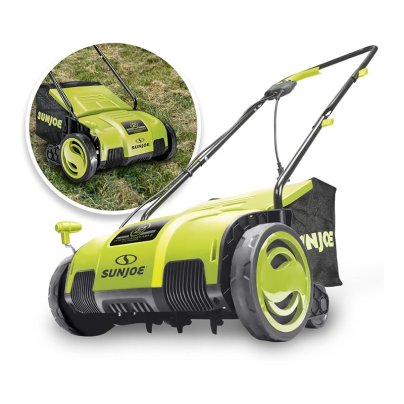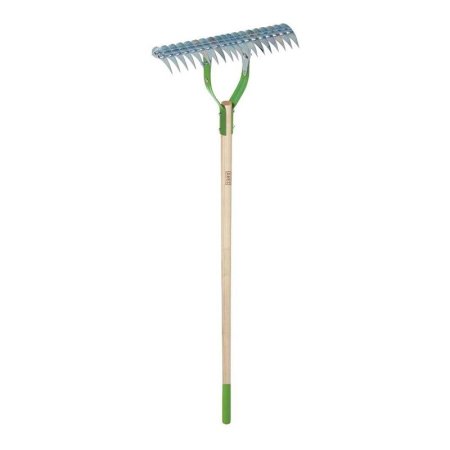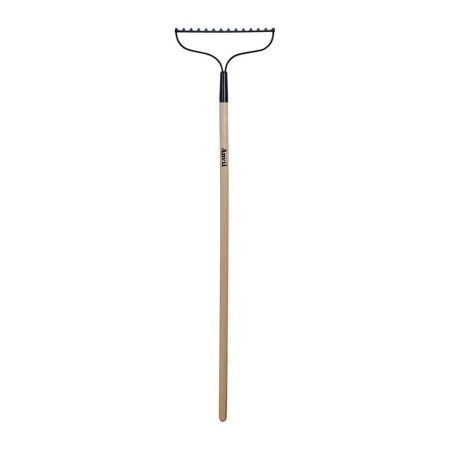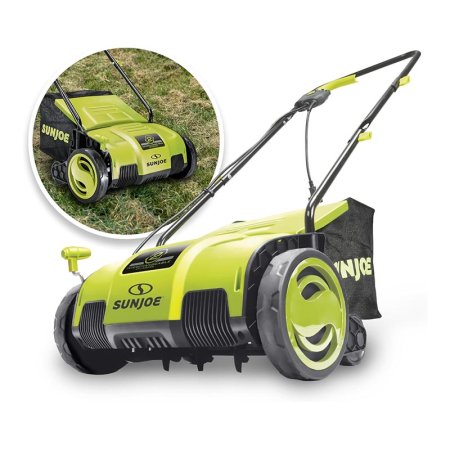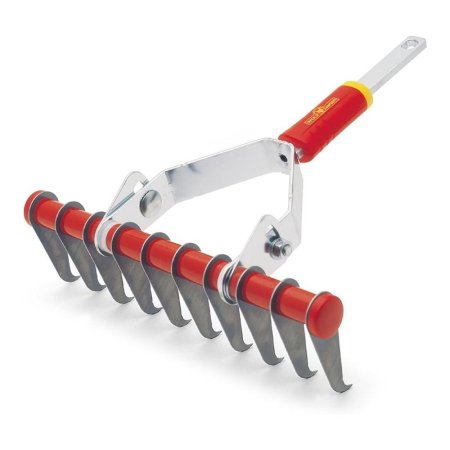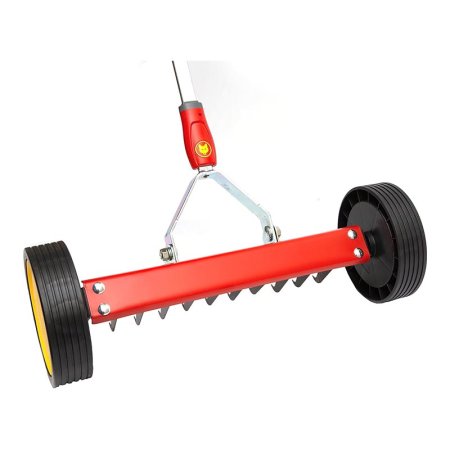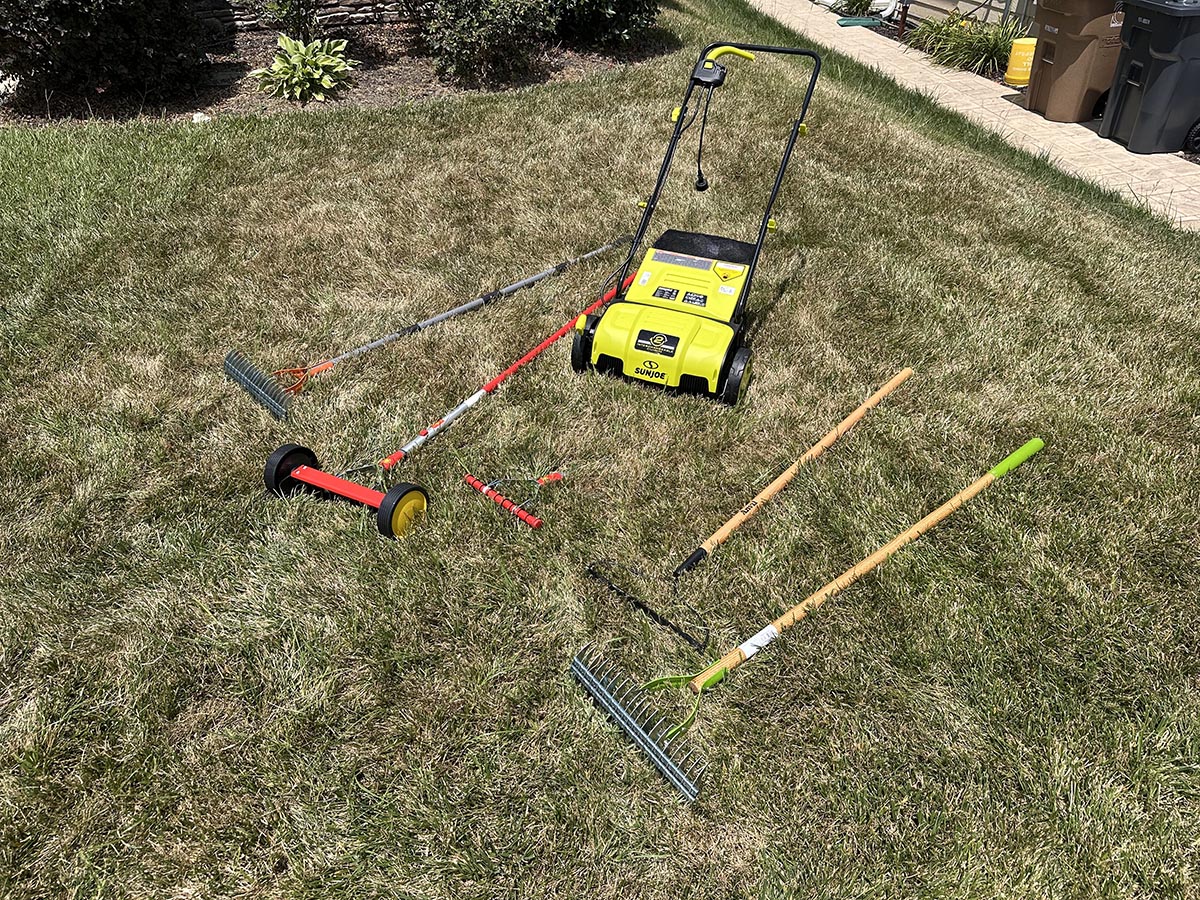
We may earn revenue from the products available on this page and participate in affiliate programs. Learn More ›
Without the benefit of dethatching rakes, dead grass clippings can accumulate between the green leafy blades of grass and the soil, creating a layer known as thatch. While a thin ½-inch layer of thatch provides much-needed nutrients to a lawn, a layer that grows to 1 inch or more can prevent nutrients and water from reaching the soil, stifling the growth of healthy grass. When that happens, a good lawn dethatching rake effectively removes the buildup of grass.
The best dethatching rake has a head with curved steel tines that can sink into the thatch layer and pull it off the grass. The head attaches to a sturdy hardwood or fiberglass handle that is long enough to allow the user to apply the necessary leverage to remove the thatch.
After testing the six dethatching rakes, my favorite was the Ames 15″ Adjustable Thatch Rake, which is effective at removing thatch, is affordable, and has excellent build quality. Ahead, discover how the other models I tested fared and learn which factors to consider when shopping for some of the best dethatching rakes on the market today.
- BEST OVERALL: Ames 15″ Adjustable Thatch Rake
↓ Jump to Review - BEST BANG FOR THE BUCK: Anvil 51″ Wood Handle Steel 14-Tine Bow Rake
↓ Jump to Review - UPGRADE PICK: Sun Joe 12.6″ Electric Lawn Dethatcher + Scarifier
↓ Jump to Review - BEST DESIGN: Wolf-Garten Interlocken Dethatching Rake
↓ Jump to Review - BEST WITH WHEELS: Wolf-Garten Scarifying Roller Rake
↓ Jump to Review - ALSO CONSIDER: Walensee 15″ Thatch Rake With Adjustable Steel Handle
↓ Jump to Review
| Testing Stats | |
| Products tested | 6 |
| Time spent testing | 4 hours |
| Tests performed | 1 |
| Price range | $15 to $190 |
Our Top Picks
These top picks feature manual dethatching rakes with designs and materials that are effective at removing thatch as well as power rake dethatchers and tow-behind dethatchers. One of these best dethatching rakes available today may be most suited for your particular lawn.
Best Overall
Ames 15" Adjustable Thatch Rake
Product Specs
- Type: Manual
- Head width: 15 inches
- Handle: Hardwood with rubber grip
Our Ratings: Ease of Use 4/5; Effectiveness 4.5/5; Durability 5/5; Value 4.5/5
What We Like
- Sturdy construction
- Well-designed curved and pointed tines
- Adjustable head
What We Don’t Like
- Rake is heavy
The smart design and sturdy construction of this Ames adjustable thatch rake make it an ideal option for users with small- to medium-size yards. While this rake looks similar to other manual dethatching tools, unique features on the head and tines set it apart from the rest. The formidable-looking curved tines taper to sharp points, making them well suited for pulling up thatch without damaging the lawn.
However, there is a learning curve to using this dethatching rake. I started my testing with the head adjusted at too aggressive of an angle, which caused me to pull out a sizable amount of turf along with the offending thatch. After a little tweaking to the head angle, I was able to resolve that issue. The design of the tines proved to be very effective as they removed large amounts of thatch with each pull.
I also found this rake to be durable and easy on the hands, thanks to a hardwood handle fitted with a cushioned grip. While I liked the sturdy feel, this handle did make the rake quite a bit heavier than other models constructed with lighter materials. The verdict? The Ames dethatching rake is about as effective an option as you’ll find for dethatching manually—affordable, effective, and well built.
Get the Ames dethatching rake at The Home Depot.
Best Bang for the Buck
Anvil 51" Wood Handle Steel 14-Tine Bow Rake
Product Specs
- Type: Manual
- Head width: 13.75 inches
- Handle: Hardwood with rubber grip
Our Ratings: Ease of Use 4.5/5; Effectiveness 5/5; Durability 4/5; Value 4.5/5
What We Like
- Affordably priced
- Versatile; for use with various jobs
- Durable steel and hardwood construction
What We Don’t Like
- Not as effective as a dethatching rake
Unlike the other dethatching rakes and machines I tested, the Anvil bow rake is not specifically designed for removing thatch. As such, I was surprised at just how effective it was at this task. After figuring out the best angle of attack, I was able to pull up thatch while leaving green grass relatively unscathed. I also liked the sturdy feel of the handle and the tough metal rake head. This is a durable tool that will last a long time. That’s not to say dethatching with it was easy, as a bow rake does require more physical effort to remove thatch than the specialty tools I tested.
This Anvil bow rake was by far the most economical option of the models I tested, costing just a fraction of the price of specialized dethatching rakes. Plus, it is versatile—an excellent go-to tool for a variety of other landscaping needs, ranging from cultivating a garden to spreading gravel.
The low price and versatility make this rake a suitable choice for smaller lawns or users with minor thatch issues, as both are scenarios in which spending money on a specialized dethatching rake doesn’t make sense.
Get the Anvil dethatching rake at The Home Depot.
Upgrade Pick
Sun Joe 12.6" Electric Lawn Dethatcher + Scarifier
Product Specs
- Type: Electric
- Dethatching width: 12.6 inches
- Weight: 21 pounds
Our Ratings: Ease of Use 4.5/5; Effectiveness 5/5; Durability 4/5; Value 4.5/5
What We Like
- Removes large amounts of thatch quickly
- Lightweight design makes it easy to push
- Also functions as a scarifier
What We Don’t Like
- Bagging attachment doesn’t work
If you have a lot of ground to dethatch, then it may make sense to invest in this upgrade pick over a manual dethatching rake. The corded electric Sun Joe motorized lawn dethatcher, which looks very similar to a small walk-behind lawn mower, removes thatch using a tined cylinder head powered by a 12-amp motor.
During testing, I found the Sun Joe to be a thatch-removing beast. It removed large amounts of dead grass and debris with each step I took. The motor is powerful, having no problem working through even thicker grass. And since it weighs just 21 pounds., pushing it around the yard was an easy task.
The Sun Joe electric dethatcher is versatile, too. It includes two attachments: a dethatching cylinder and a separate scarifying cylinder that digs deeper to aerate the soil and remove moss. Both attachments worked equally well.
What didn’t work was the bagger attachment, which failed to collect the thatch, instead leaving it on the ground for me to rake up later. However, this would have been more disqualifying had any of the baggers on the three other motorized dethatchers I tested worked, but those baggers proved just as disappointing. Bagging issues aside, the Sun Joe electric dethatcher is a great option for removing thatch from a larger area.
Get the Sun Joe electric lawn dethatcher at Amazon or Walmart.
Best Design
Wolf-Garten Interlocken Dethatching Rake
Product Specs
- Type: Manual
- Head width: 12 inches
- Handle: Sold separately
Our Ratings: Ease of Use 4.5/5; Effectiveness 5/5; Durability 5/5; Value 3.5/5
What We Like
- Thin, curved tines create minimal damage to the lawn
- Sturdy steel construction
- Adjustable head angle
What We Don’t Like
- Handle is sold separately
The wide design and hook shape of the tines of this Wolf-Garten dethatching rake make it one of the best tools for removing dead grass from a suffocated yard.
This rake pulled up thatch easily during my testing. The hook-shaped tines dig into thatch while exacting minimal damage to healthy grass. Coupled with the lightweight fiberglass handle, which I had to purchase separately, it was one of the easier manual dethatchers to operate. As with other dethatching rakes I tested, the head angle is adjustable, making it easier to determine the optimal tine angle for dethatching. That said, it does offer less coverage than other manual rakes: The head is just 12 inches wide, narrower than the 15-inch heads on some of the other rakes I tested.
While this dethatching rake features top-notch build quality, it is also one of the priciest models once you factor in the separate cost of the handle. The rake head is part of the Wolf-Garten Interlocken system, which allows you to attach and detach various garden tool heads to the handle. If you plan on investing in other Wolf-Garten tool heads, then purchasing this dethatching rake makes more economic sense. If not, other effective dethatcher options on the market are far more affordable.
Get the Wolf-Garten Interlocken dethatching rake at Amazon.
Best with Wheels
Wolf-Garten Scarifying Roller Rake
Product Specs
- Type: Manual
- Head width: 14.96 inches
- Handle: Sold separately
Our Ratings: Ease of Use 4/5; Effectiveness 4/5; Durability 5/5; Value 3.5/5
What We Like
- Wheels make it easier to operate
- Maintains level height for tines
- Durable steel construction
What We Don’t Like
- Handle sold separately
- Tines not as wide as other manual rake heads
Similar to other manual dethatching rakes, the Wolf-Garten scarifying roller rake has a set of effective tines that dig into the lawn to latch onto thatch and pull it up and away from the soil—although this model also features two wheels attached to the head. Rather than using a repeated raking motion, you simply pull the rake on the wheels through the lawn to dig up the thatch.
The wheels definitely added some benefits to the dethatching rake during testing. First, the wheels keep the rake at a set height, making it easier to dethatch the yard at a consistent angle to avoid pulling up healthy grass. Since the wheels support the head, this rake is less strenuous to use than a manual rake, though it still requires a fair amount of effort to pull up thatch. As with the other Wolf-Garten rake I tested, this model has tremendous build quality with its durable stainless steel construction.
While the wheels are a smart and effective design, this scarifying roller rake is also quite pricey once you factor in the cost of the handle, which is sold separately. As with the previous Wolf-Garten rake I tested, this rake is part of the Wolf-Garten Interlocken system, meaning the handle will work with a whole host of tool heads. If you plan on investing in other Wolf-Garten tool heads, then it makes more financial sense to choose this manual dethatcher on wheels.
Get the Wolf-Garten scarifying dethatching rake at Amazon.
Also Consider
Walensee 15" Thatch Rake With Adjustable Steel Handle
Product Specs
- Type: Manual
- Head width: 15 inches
- Handle: Steel
Our Ratings: Ease of Use 5/5; Effectiveness 4/5; Durability 4/5; Value 5/5
What We Like
- Lightweight design
- Adjustable head angle
- Adjustable handle length
- Tines effective at removing thatch
What We Don’t Like
- Head wing nuts can loosen while raking
This well-designed dethatching rake from Walensee impressed me with its performance. The curved tines bit nicely into the soil, allowing me to dislodge a large amount of thatch with each pull. The angle of the head is adjustable, which made it easy to ensure that “just-right” angle for pulling up thatch without damaging the lawn. I only wish that the adjuster for the head, which is held together by two wing nuts, was a little more secure. Unless I wrenched them as tight as I could, the wing nuts tended to loosen over time, eventually causing the head to move.
This rake has a hollow steel handle that goes together in pieces. While I was skeptical of the stability of the handle at first, it was quite strong once assembled. And since it’s hollow, this dethatching rake was notably lighter than the rakes with a solid hardwood handle that I tested.
The handle is also nearly 6 feet long, which created plenty of leverage for removing thatch. You can also shorten the handle by merely removing a piece. In all, the Walensee rake is an effective, durable, and well-designed dethatching rake. Add the relatively low price tag and this model is a great manual option for dethatching yards.
Get the Walensee dethatching rake at Amazon, Lowe’s, or The Home Depot.
Jump to Our Top Picks
How We Tested the Best Dethatching Rakes
I evaluated the top six dethatching rakes by putting them to the test on my own thatch-laden backyard. I began by marking off seven evenly sized 20-foot-long by 6-foot-wide strips of turf, assigning one dethatcher to each strip. I then used each rake to remove the thatch in a separate strip, considering several factors as I tested. Specifically, I looked at how well each rake collected the thatch and evaluated the amount of damage each rake inflicted on healthy grass. I considered the ease of use of each rake, taking into account how much physical effort each model demanded of me. Durability and build quality were also part of my testing process.
Finally, I noted my observations and scored each dethatching rake on a rubric, awarding a Best Overall pick and a category to the other six rakes that best represented their strengths.
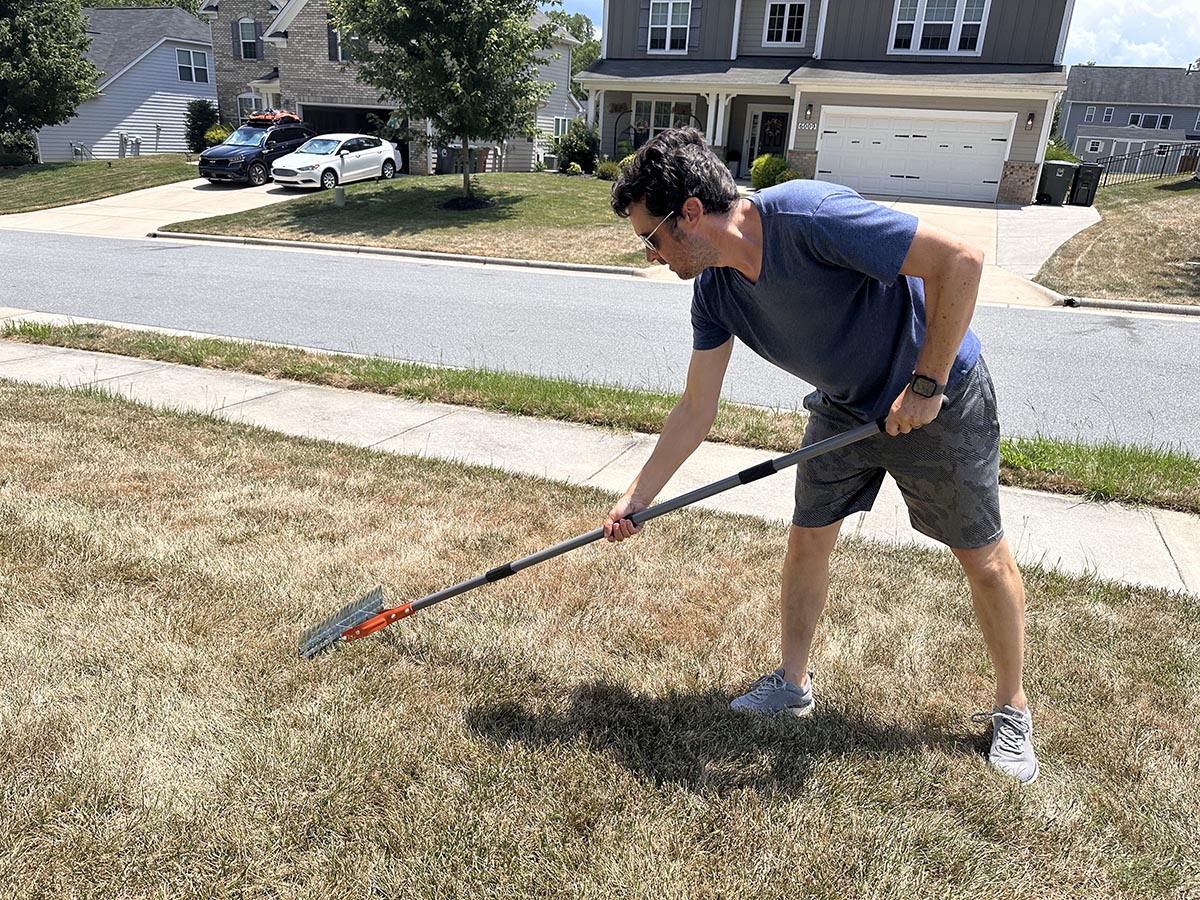
What to Consider When Choosing a Dethatching Rake
The best dethatcher rake consists of a handle attached to a head with metal tines responsible for pulling loose thatch without damaging the healthy grass. Keep reading to learn more about types of dethatching rakes and the parts of a dethatching rake.
Types of Dethatching Rakes
To find the best rake for dethatching your lawn, you’ll want to consider the different rake types: manual, power, and tow behind.
Manual
The most affordable type of dethatcher for lawns is a manual rake, which looks very similar to a standard rake you would use to gather leaves in the yard. However, dethatching rakes differ in that they feature thinner tines specifically designed to bite into the soil and pull up dead grass.
Unlike a power dethatcher or a tow-behind dethatcher, this style requires the user to supply all of the force needed for removing thatch. In addition to being less expensive, a manual rake for dethatching takes up much less room than power or tow-behind dethatchers.
Power
The best power rake looks similar to a small lawn mower, only instead of a spinning blade that cuts grass, it is equipped with a cylinder covered in dethatcher tines. A motor powers the cylinder, which spins through the lawn pulling up dead grass.
A dethatching power rake uses an electric motor and can be plugged into a standard outlet. Since these models require a power cord, they have limited range, making them more suitable for smaller yards.
Tow Behind
A tow-behind dethatcher consists of a metal frame with several rows of tines that extend beneath it. The frame sits on two wheels and has a hitch that attaches to the back of a riding lawn mower or ATV, which tows the dethatcher.
A tow-behind dethatcher is usually about 4 feet wide, allowing it to cover a broad area with each pass. Some of the best tow-behind dethatchers have handles that allow the operator to adjust the height of the tines. While its broad width makes this type of dethatcher suitable for large yards, it can be more of a challenge to operate due to the bulky size.
Tines
The tines are the metal prongs that extend from the dethatching rake. Unlike a leaf rake that has wide tines to snag leaves, the tines on a dethatching rake are thinner and feature pointy tips that pull up thatch without damaging the soil and healthy grass. The tines are also curved so they bite into the thatch.
Since pulling up thatch requires more force than raking leaves, the best rake to dethatch lawns is made of steel, which is strong enough to pull up dense layers of dead grass without bending or breaking. Some dethatching rakes have tines on the opposite side of the head that are designed to prepare soil for reseeding after you have removed the offending thatch.
Head
The head of a rake for dethatching lawns consists of tines and a frame to secure them. A dethatcher rake head typically varies in width between 12 and 15 inches. The wider the head, the more thatch the rake can remove in a single pass.
Keep in mind that a dethatching rake with a wider head and more tines will require more force to pull it through the thatch than one with a narrower head. Some dethatching rakes have adjustable heads that allow the user to change the head’s angle in relation to the handle for more precision while dethatching.
Handle
The best dethatching rakes have handles that are thicker than a leaf rake. These handles, which are typically made of hardwood, can withstand the force required to pull the rake head through dense thatch without bending or breaking.
Some rakes feature fiberglass handles, which have similar strength qualities as hardwood but are much lighter. They are also typically more expensive. Dethatching rake handles also usually come equipped with a rubber cover, allowing the user to get a firm, comfortable, and secure grip on the rake.
FAQs
If you’re wondering how to measure the amount of thatch in your lawn or if a standard rake will do the job of dethatching lawns, then read on for answers to some of the most popular questions about these lawn care tools.
It’s possible to find out how much thatch your lawn has by removing a 2-inch deep chunk from the yard. After removing the sample, measure the amount of spongy material between the soil and the green grass. If it’s more than ¾ inch thick, you have too much thatch in your lawn.
Whether or not a dethatching rake is worth it depends on the condition of your lawn. If your lawn frequently has problems with too much thatch, then a dethatching rake can be a good investment to protect the health of your lawn.
September is the best time of year for dethatching. In the late summer and early fall, the weather begins to cool, and your lawn begins to thrive. These cooler temperatures also allow the lawn to recover from the stress of dethatching.
Dethatch your lawn twice a year. Do it once in the spring to remove any thatch packed down by snow and then again in the late summer or early fall to remove any thatch that has accumulated from summer mowing.
You shouldn’t use a regular leaf rake to remove thatch from a lawn. When you dethatch with a rake, you won’t effectively remove dead grass from the lawn and may damage healthy grass. That said, it is usually safe to use a regular metal rake for lawns with minor thatch issues.
You can break down thatch naturally and avoid a dethatching tool altogether by following a few steps. Make sure to always keep the soil under the thatch moist. Collect any lawn clippings in the lawn mower bag until the thatch problem is under control, and add fertilizer with nitrogen to help speed up the decomposition process of the dead grass.
Meet the Tester
Tony Carrick is a freelance writer specializing in home improvement, landscaping, technology, home security, and design. Carrick has conducted rigorous product testing on everything from power tools to home security systems to backyard grills. With each review, his goal is to help readers determine whether a product meets their needs and if it is or isn’t worth its price tag.


